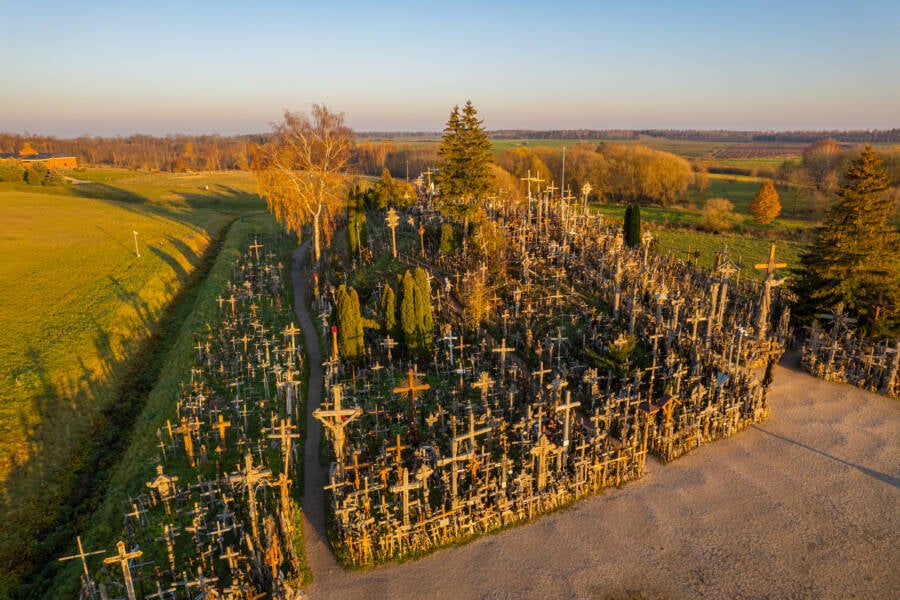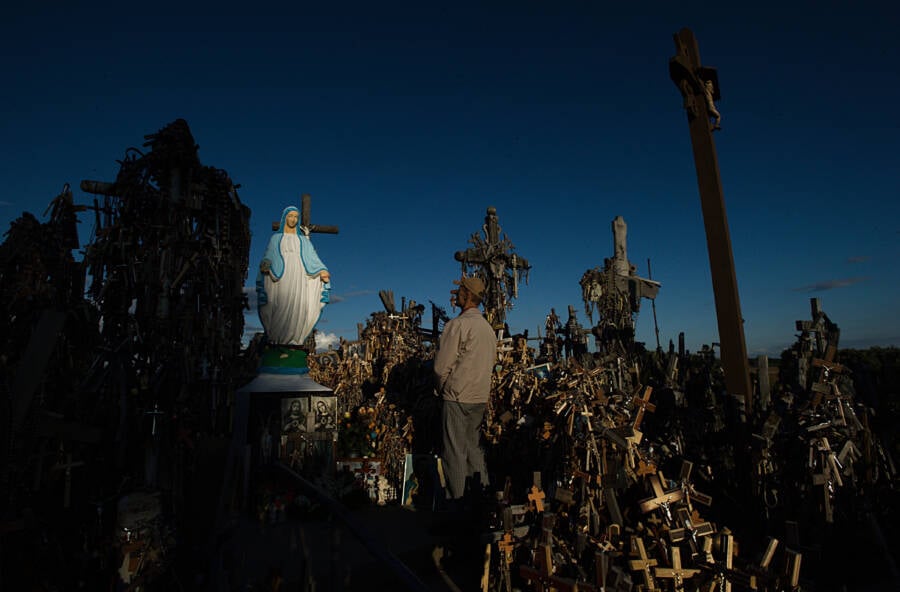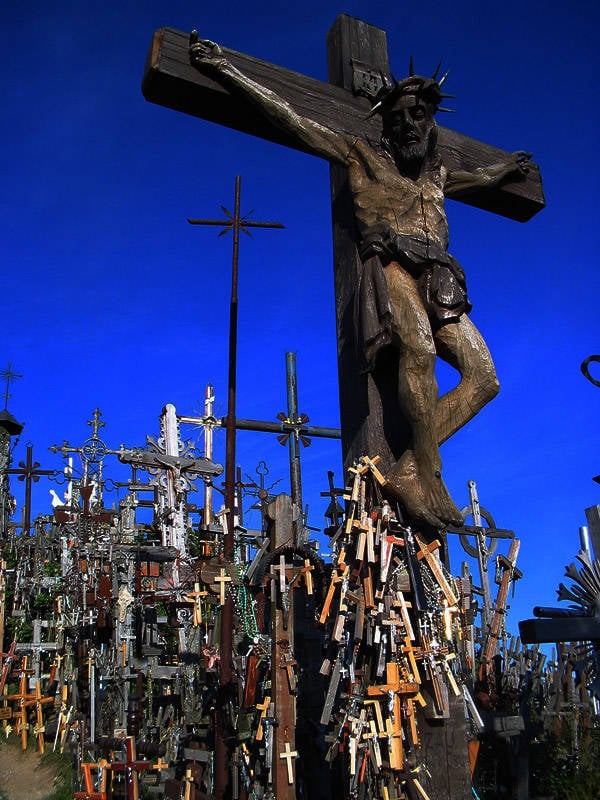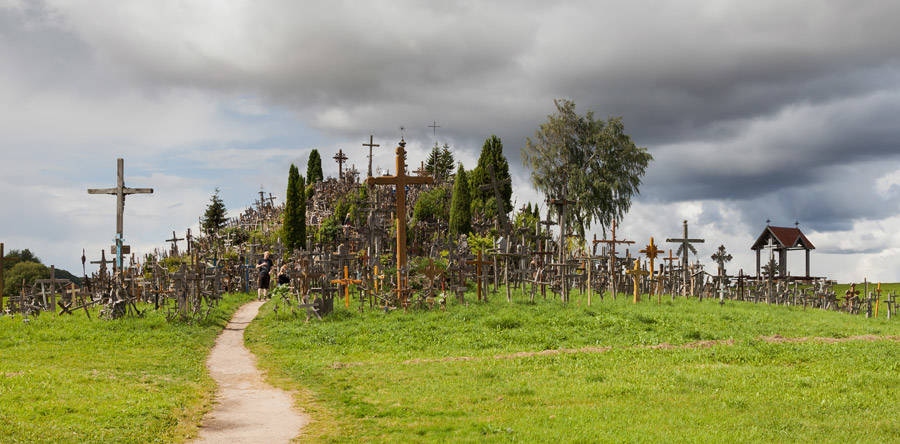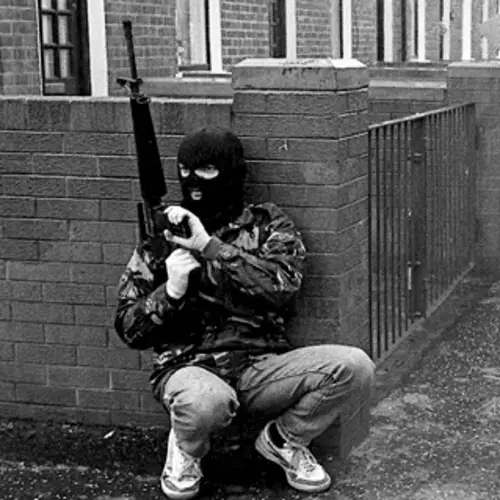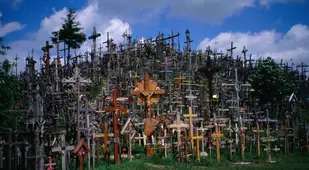Laden with more than 100,000 Christian symbols, Lithuania's Hill of Crosses is one of the world’s most unique pilgrimage sites.
In the Lithuanian countryside sits a hill covered in crosses placed there by those who have lost loved ones. The last count in 2006 put the number of crosses at about 100,000, but according to some recent estimates, that number has now swelled to over 200,000.
Over the years, Kryžių Kalnas, translated as “Hill of Crosses,” has become somewhat of a holy mecca for the country’s Catholics and religious devotees around the world, who make the pilgrimage to bring new crosses to the hill.
While the site’s exact origins remain a mystery, for many Lithuanians, Kryžių Kalnas stands as a testament to the country’s faith and sacrifice. Because although today it is a popular cultural landmark, there was once a time when placing a cross at Kryžių Kalnas was viewed as an act of rebellion.
The Mysterious Origins Of The Hill Of Crosses
Situated just 12 kilometers — about 7 miles — north of the city of Šiauliai, the hill has been covered in crosses for as long as anyone can remember. And while the precise origin of the Hill of Crosses is unknown, it’s possible people have been placing crosses there since as early as the Middle Ages.
A number of legends have emerged over the years to explain how the site came to be.
"The hill has many secrets," artist and historian Vilius Puronas told the BBC. "Throughout the ages, magical appearances, visions of saints, and sightings of ghosts have been a part of the hill's history."
One popular legend says that an apparition of the Virgin Mary, the baby Jesus cradled in her arms, once appeared to the faithful and asked them to decorate the site with holy symbols.
Another origin story says that the tradition of laying crosses on the hill began with a distraught father whose daughter had fallen ill. The story goes that as the girl lay dying, a woman came to the father in a vision, telling him that if he made a wooden cross and placed it on a hill nearby, his daughter would survive her illness. The man immediately carved a cross and rushed to place it on the hill — and when he returned, his daughter was cured.
But not all of the stories surrounding Kryžių Kalnas are quite so uplifting. One chilling tale says that the site where the hill now stands was once a church — until lightning struck the building during a terrible storm, burying the church and everyone inside under mounds of sand and rock.
To this day, locals say that if you visit the hill at sunrise, you can glimpse a ghostly procession of monks walking by.
Yet another legend says that a castle owned by pagan Samogitian barons once stood there until it was destroyed by the Christian Order of the Brothers of the Sword. It's said that the bodies of the slain Samogitian people were piled up and buried together, forming the mound that later became the Hill of Crosses, and that their souls haunt the hill to this day.
Kryžių Kalnas, A Symbol Of Peaceful Resistance
While there's some debate over when the first crosses appeared on the hill, according to National Geographic, the first official written mention of the Hill of Crosses appeared in 1850. And there's evidence that people were placing them at least as far back as the 1830s.
The Tsarist autocracy that controlled Lithuania at the time had strict orders for how relatives could honor their dead, and many believe the first crosses were placed on the hill to honor those who had lost their lives rebelling against the Russians in 1831.
Then, at the beginning of the 20th century, the number of crosses on the hill began to grow significantly — particularly following World War I. By the time the Soviet Union entered World War II, the number of crosses at Kryžių Kalnas had swelled to more than 400.
In 1940, Soviet Union troops entered the country, which soon fell under U.S.S.R. control. According to the Encyclopedia Britannica, the Soviet occupation of Lithuania was a turbulent time. Right from the start, the Soviets began to dramatically change the political, social, economic, and cultural makeup of Lithuania.
And in the decades following World War II, the Soviet government came to view the Hill of Crosses as a nuisance — and eventually, a symbol of rebellion against Soviet rules about religion.

Thierry Tronnel/Corbis via Getty ImagesTwo women walking along a trail through the Hill of Crosses.
In retaliation to this perceived slight, the Soviets bulldozed and burned the holy site, turning the wooden crosses into firewood and sending the metal ones off to the scrapyard.
This happened a total of five times, but locals continued to rebelliously sneak onto the site at night to erect more crosses. The number of crosses on the hill kept growing despite Soviet efforts to destroy them, and Kryžių Kalnas soon became an icon of resistance to religious oppression.
Then, in 1990, Lithuania finally declared its independence from the U.S.S.R. — and the Soviet Union collapsed the following year.
The State Of The Hill Of Crosses Today
Finally, after years of occupation and oppression, Lithuania was an independent country, and the people of Lithuania were free to openly practice their religion.
Throughout the country's turbulent history, cross-making and the carving of religious icons had long been an important part of Lithuania's cultural heritage. Today, UNESCO recognizes the act of cross-making as a "symbol of national and religious identity" for the Lithuanian people.
But the Hill of Crosses represents something more: a place of unity in the face of adversity.
In 1993, only a mere two years after the people of Lithuania became able to openly practice their religion, Pope John Paul II visited the Hill of Crosses. While taking in the sight, the pontiff declared it a place of hope, love, peace, and sacrifice.
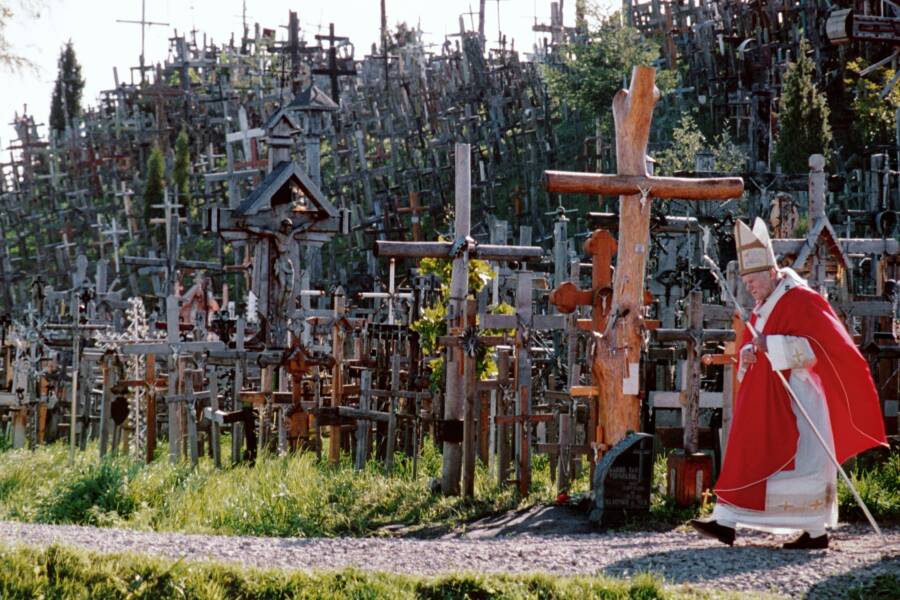
MLADEN ANTONOV/AFP via Getty ImagesPope John Paul II walking past the Hill of Crosses on September 7, 1993.
Today, no single entity holds jurisdiction over the Hill of Crosses. The site is instead maintained by a handful of volunteers and a collection of organizations working to preserve the cultural and spiritual landmark.
And Kryžių Kalnas has become a place of significance, not just for the people of Lithuania, but for religious devotees and pilgrims across the world.
"It doesn't matter who you are, what religious confession you follow, or at what time you come, since the canonical rituals of the Church are not so important here," Rūta Stankuvienė, the director of the Šiauliai Tourism Information Center, told National Geographic. "The doors of this place are always open because there are no doors at all. Here, nature mingles with culture, including any person in the completely unique experience."
After learning about Kryžių Kalnas, the Hill of Crosses, discover these breathtaking photos of holy places around the world. Then, learn about Edinburgh Castle, the Scottish fortress that's been besieged more times than any other place in Britain.


